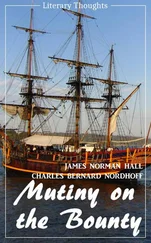At the head of the tramway on the Grand Rapids portage stands the Great House, facing old warehouses through which have passed millions of dollars' worth of furs. The Great House is gambrel-roofed and is built of heavily timbered logs whitewashed. Round it is a picket fence; below are wine cellars. It is dismantled and empty now; but here no doubt good wines abounded and big oaths rolled in the days when the lords of an unmapped empire held sway.

THE PRINCIPAL POSTS OF THE HUDSON'S BAY COMPANY
Map by Bartholomew.
A glance at the map of the Hudson's Bay Company's posts will show the extent of the fur traders' empire. To the Athabaska warehouses at Fort Chipewyan came the furs of Mackenzie river and the Arctic; to Fort Edmonton came the furs of the Athabaska and of the Rockies; to Fort Pitt came the peltry of the Barren Lands; and all passed down the broad highway of the Saskatchewan to Lake Winnipeg, whence they were sent out to York Factory on Hudson Bay, there to be loaded on ships and taken to the Company's warehouses in London.
Incidentally, the fur hunters were explorers who had blazed a trail across a continent and penetrated to the uttermost reaches of a northern empire the size of Europe. But it was fur these explorers were seeking when they pushed their canoes up the Saskatchewan, crossed the Rocky Mountains, went down the Columbia. Fur, not glory, was the quest when the dog bells went ringing over the wintry wastes from Saskatchewan to Athabaska, across the Barren Lands, and north to the Arctic. Beaver, not empire, was the object in view when the horse brigades of one hundred and two hundred and three hundred hunters, led by Ogden, or Ross, or M'Kay or Ermatinger went winding south over the mountains from New Caledonia through the country that now comprises the states of Washington and Oregon and Idaho, across the deserts of Utah and Nevada, to the Spanish forts at San Francisco and Monterey. It is a question whether La Salle could have found his way to the Mississippi, or Radisson to the North Sea, or Mackenzie to the Pacific, if the little beaver had not inspired the search and paid the toll.
CHAPTER II – THE TRAGEDY OF HENRY HUDSON
Though the adventurers to Hudson Bay turned to fur trading and won wealth, and discovered an empire while pursuing the little beaver across a continent, the beginning of all this was not the beaver, but a myth—the North-West Passage—a short way round the world to bring back the spices and silks and teas of India and Japan. It was this quest, not the lure of the beaver, that first brought men into the heart of New World wilds by way of Hudson Bay.
In this search Henry Hudson led the way when he sent his little high-decked oak craft, the Discovery, butting through the ice-drive of Hudson Strait in July of 1610; 'worming a way' through the floes by anchor out to the fore and a pull on the rope from behind. Smith, Wolstenholme, and Digges, the English merchant adventurers who had supplied him with money for his brig and crew, cared for nothing but the short route to those spices and silks of the orient. They thought, since Hudson's progress had been blocked the year before in the same search up the bay of Chesapeake and up the Hudson river, that the only remaining way must lie through these northern straits. So now thought Hudson, as the ice jams closed behind him and a clear way opened before him to the west on a great inland sea that rocked to an ocean tide.
Was that tide from the Pacific? How easily does a wish become father to the thought! Ice lay north, open water south and west; and so south-west steered Hudson, standing by the wheel, though Juet, the old mate, raged in open mutiny because not enough provisions remained to warrant further voyaging, much less the wintering of a crew of twenty in an ice-locked world. Henry Greene, a gutter-snipe picked off the streets of London, as the most of the sailors of that day were, went whispering from man to man of the crew that the master's commands to go on ought not to be obeyed. But we must not forget two things when we sit in judgment on Henry Hudson's crew. First, nearly all sailors of that period were unwilling men seized forcibly and put on board. Secondly, in those days nearly all seamen, masters as well as men, were apt to turn pirate at the sight of an alien sail. The ships of all foreign nations were considered lawful prey to the mariner with the stronger crew or fleeter sail.

THE ROUTES OF HUDSON AND MUNCK
Map by Bartholomew.
The waters that we know to-day as the Pacific were known to Hudson as the South Sea. And now the tide rolled south over shelving, sandy shores, past countless islands yellowing to the touch of September frosts, and silent as death but for the cries of gull, tern, bittern, the hooting piebald loon, match-legged phalaropes, and geese and ducks of every hue, collected for the autumnal flight south. It was a yellowish sea under a sky blue as turquoise; and it may be that Hudson recalled sailor yarns of China's seas, lying yellow under skies blue as a robin's egg. At any rate he continued to steer south in spite of the old mate's mutterings. Men in unwilling service at a few shillings a month do not court death for the sake of glory. The shore line of rocks and pine turned westward. So did Hudson, sounding the ship's line as he crept forward one sail up, the others rattling against the bare masts in the autumn wind—doleful music to the thoughts of the coward crew. The shore line at the south end of Hudson Bay, as the world now knows, is cut sharply by a ridge of swampy land that shoals to muddy flats in what is known as Hannah Bay.
Hudson's hopes must have been dimmed if not dashed as he saw the western shore turn north and bar his way. He must suddenly have understood the force of the fear that his provisions would not last him to England if this course did not open towards China. It was now October; and the furious equinoctial gales lashed the shallow sea to mountainous waves that swept clear over the decks of the Discovery, knocking the sailors from the capstan bars and setting all the lee scuppers spouting. In a rage Juet threw down his pole and declared that he would serve no longer. Hudson was compelled to arrest his old mate for mutiny and depose him with loss of wages. The trial brought out the fact that the crew had been plotting to break open the lockers and seize firearms. It must be remembered that most of Hudson's sailors were ragged, under-fed, under-clothed fellows, ill fitted for the rigorous climate of the north and unmoved by the glorious aims that, like a star of hope, led Hudson on. They saw no star of hope, and felt only hunger and cold and that dislike of the hardships of life which is the birthright of the weakling, as well as his Nemesis.
What with the north wind driving water back up the shallows, and with tamarac swamps on the landward side, Hudson deemed it unwise to anchor for the winter in the western corner of the Bay, and came back to the waters that, from the description of the hills, may now be identified as Rupert Bay, in the south-east corner. The furious autumn winds bobbled the little high-decked ship about on the water like a chip in a maelstrom, and finally, with a ripping crash that tore timbers asunder, sent her on the rocks, in the blackness of a November night. The starving crew dashed up the hatchway to decks glassed with ice and wrapped in the gloom of a snow-storm thick as wool. To any who have been on that shore in a storm it is quite unnecessary to explain why it was impossible to seek safety ashore by lowering a boat. Shallow seas always beat to wilder turbulence in storm than do the great deeps. Even so do shallow natures, and one can guess how the mutinous crew, stung into unwonted fury by cold and despair, railed at Hudson with the rage of panic-stricken hysteria. But in daylight and calm, presumably on the morning of November 11, drenched and cold, they reached shore safely, and knocked together, out of the tamarac and pines and rocks, some semblance of winter cabins.
Читать дальше














